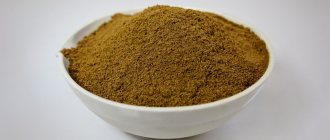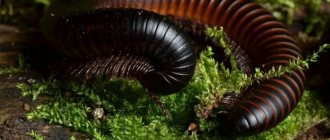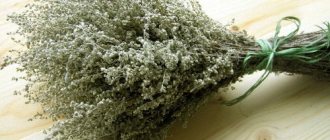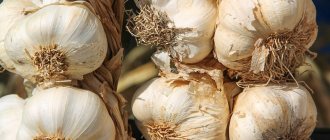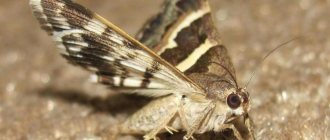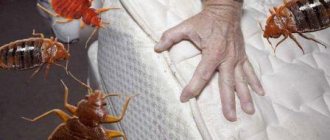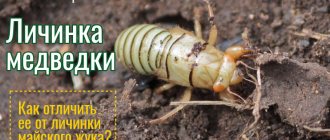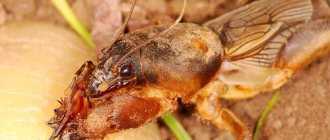Not a single summer resident is safe from a mole cricket invasion. This harmful insect usually leads an underground lifestyle, under certain circumstances it can fly, and even better, dig tunnels underground. And although it thereby improves soil aeration, this is incompatible with the damage that the mole cricket causes to garden crops.
It is impossible to catch this insect without resorting to certain tricks: the mole cricket appears on the surface infrequently and mainly at night. And it generally overwinters at a depth of 60 cm. It can while away the winter in compost, which also does not look like a joy for the garden owner. But there is also good news.
A cruel joke on the mole cricket is often played by its addiction to beer: some savvy summer residents dig traps in the garden in the form of plastic bottles with the neck cut off, at the bottom of which there are remains of the drink. The insect climbs inside, “has a meal”, but it is difficult for it to get back out, and it dies inside the bottle. You can also use this method. But if you don’t drink beer or you’re sorry to share it with a mole cricket, then there are methods to repel this pest.
Subtleties of fighting mole crickets
In the fight for a whole harvest, it is necessary to understand the peculiarities of hunting the mole cricket pest.
She loves well-groomed plantings and nutritious soil. Strong claws easily tear apart tunnels underground, tearing roots and greenery. The insect has features:
Medvedka: photo.
- The mole cricket has a powerful shell, it cannot be easily crushed;
- the pest’s excellent sense of smell allows it to be selective in its feeding;
- the large mole cricket is only clumsy in appearance, it is very fast and active;
- The animal is nocturnal and is almost impossible to see during the day.
Plant repellent plants
The easiest way to keep mole crickets away from your area. There are plants whose smell repels pests. These are marigolds, calendula, chrysanthemum - they can be planted near garden plantings, taking into account the characteristics of a successful neighborhood. Medium-thick alder or aspen branches with bark, stuck into the ground to a depth of about 30 cm, will also save the situation.
The insect does not like the smell of fresh pine needles. You can also take advantage of this and place branches of spruce, fir, and pine trees between the rows of plantings.
According to one version, the mole cricket received its Russian-language name because it spends the winter in deep holes, like a bear in a den.
Rules for using eggshells
Summer residents and gardeners say that the use of eggshells has become a real panacea and salvation from mole crickets. It needs to be dried and crushed.
There are two main methods of protection using shells: barriers and baits.
Eggshell barriers
Eggshells in the rows.
You will need a lot of eggshells, so it is better to collect them in advance. Dry egg shells are an obstacle for the mole cricket’s delicate body. It is crushed and scattered between rows before planting crops.
The depth of application should be at the level of future plantings, approximately up to 15 cm. The action is simple - the mole cricket will touch the sharp edges of such an improvised barrier, this causes discomfort and forces the pest to escape.
Bait
Eggshells: instructions for use.
Bait is made from crushed eggshells. To do this, you need to prepare porridge, add grated egg crust and butter to it. Moreover, it is better to choose vegetable oil with a strong smell. It will be a good bait.
You need to prepare small circles from porridge and shells with the addition of oil and place them near the plants, along the perimeter of the area and in the holes.
A mole cricket comes to the scent, eats the bait and dies because it cannot digest it.
Features of the fighting method
The activity of the mole cricket in the garden causes a lot of harm: it cuts the stems of plants, which then die. There are fixed instructions on how to use eggshells against mole crickets, but with some nuances.
- Pre-dry, crush, place in holes before planting seedlings, in holes with potatoes, between rows of sown seeds.
- Fertilize the dried, crushed shells with several tablespoons of aromatic vegetable oil. Lay out in the same way as the first method.
On a note!
Since the pest is active throughout the warm season, it is recommended to fight mole crickets all year round. In the fall, when digging up potatoes, beets, and carrots, the protective layer should be renewed. You can also scatter the prepared preparation over the entire plot of land, sprinkle a small layer of soil on top.
Destruction of mole crickets in the garden
To effectively combat such a serious garden pest, you need to “know it by sight.” I’ll tell you about the life functions of the mole cricket:
- The insect is nocturnal. At this time of day, it gets out to the surface of the earth and changes its location.
- The mole cricket loves warm, moist soil, illuminated by the sun during the day. It prefers a substrate richly fertilized with manure, in which a “greenhouse effect” occurs.
- The insect is unusually prolific. Up to 500 larvae can hatch from one clutch of eggs. In terms of appetite, they can compete with locusts.
The first sign of a pest appearing in the garden is small areas that look like mown grass. The mole cricket cuts it off with its powerful jaws - it fights against shading, which interferes with the breeding of offspring.
signs of a mole cricket in the garden
Carefully monitor the pest operating in your garden - its burrows can be confused with manholes, passages of shrews and moles. But each of these uninvited guests has its own methods of struggle. Traps, bait, erection of natural barriers and the use of ultrasonic repellers are effective against mole crickets. They successfully fight pests using folk remedies.
If these methods are powerless, they turn to chemicals and biological poisons. If the use of such drugs is unsuccessful, “heavy artillery” is needed - a sanitary service specializing in large-scale pest control. Professionals work with powerful chemicals that literally destroy all life on the site. Therefore, turning to such a drastic remedy is justified only in case of a large invasion of earthen crayfish.
Preventing the appearance of mole crickets
Preventive measures, first of all, include actions aimed at destroying a comfortable habitat for mole crickets. Any pest will not multiply significantly where conditions are unsuitable for it.
Such events include:
- deep tillage of the soil both in spring and autumn, destroying passages and wintering chambers;
- cleaning heaps of construction and household materials (boards, panels, film, roofing felt, iron), under which the soil warms up well and maintains high humidity;
- installation of traps in early spring and autumn before wintering (dung and food) with subsequent collection of mole crickets;
- planting repellent plants on the site (calendula, marigolds, chrysanthemums);
- removal of finished compost to the site before the autumn cold.
These measures can significantly complicate the life of a mole cricket, but they must be taken in combination, since individually none of them will be effective.
Yes, not one of the methods provides a 100% guarantee of the destruction of mole crickets. To achieve maximum effect, you need to combine them and focus on those that are most suitable for your conditions. And even with this approach, the war against land “cancer” can continue for a long time.
Apply infusions
Of course, preparing infusions that repel mole crickets will take more time, but this method is no less effective. For example, the pest cannot tolerate the smell of ammonia - so 10 ml of the substance can be safely dissolved in 10 liters of water and poured into the holes with this solution before planting cabbage, where the mole cricket especially likes to live. The second option is an infusion of onion peels, which the gardener usually always has in bulk. To prepare it, 1 kg of husk is poured into 10 liters of water and left for five days, then diluted with water in a ratio of 1:5. The garden is watered with this mixture once every two weeks.
Does a mole cricket look into your garden and what methods of repelling this pest do you use?
Protective rings and barriers
One of the most effective methods involves installing a protective fence. It is made from a plastic bottle, the bottom and neck of which are cut off. The remaining part of the container is deepened into the ground around the shoots. The mole cricket will not be able to chew through the plastic ring or crawl under it.
Plants that repel mole crickets:
Kapusyanka does not like all smells. Gardeners often use this feature to protect their crops.
Marigold
These beautiful and pleasantly smelling flowers are an effective mole cricket repeller. The aroma coming from the buds makes them fly around the garden and look for places with more favorable conditions.
To completely protect your garden plot from harmful insects, it is enough to plant marigolds along its entire perimeter.
Chrysanthemums
To save crops from mole crickets, it is not necessary to poison or kill it. It is enough to take several dozen chrysanthemum branches and dig them into the ground. The smell will repel beetles and protect the planted plants.
Coriander
The real way to drive mole crickets out of the garden involves planting coriander. It will not only protect the area, but can also be used in cooking. The roots and seeds of coriander are used as a seasoning, and the leaves are used to decorate various dishes.
Mulch the beds
It is unlikely that it will be possible to collect enough eggshells in a year to mulch the entire garden. However, everyone’s plot area is different, as are their appetites. In one house, scrambled eggs appear on the table a couple of times a month, and in another, where a large family lives, the daily diet includes not only everyone’s favorite fried eggs and scrambled eggs, but also a variety of salads with the addition of this product, casseroles, homemade baked goods, etc. d. Here the number of inedible shells can be measured in buckets. This is enough to cover the soil surface in several beds or mulch all the tree trunks of berry bushes.
Some people eat a dozen eggs in one sitting.
In any case, the benefits of shell mulch are undeniable. Thanks to its strong structure, it does not rot for a long time, therefore it reliably protects the soil from drying out during drought and does not give weeds a single chance of survival, and at the end of its mission it saturates the soil with useful compounds. To ensure that such mulch allows air to pass well to the roots of plants, you should not turn it into flour - break the shells into large pieces.
Crushed eggshells are an excellent mulching material.
Composition and beneficial properties
The shell is a natural source of nutrients that are easily absorbed by plants. You should not throw away this natural fertilizer; it is better to learn how to use it correctly.
The chemical composition of the shell depends on the breed and age of chickens, diet, and time of year:
- 90-93% comes from easily digestible calcium;
- nitrogenous substances contain up to 3.3%;
- water – 1.6-2%;
- microelements;
- traces of lipids.
Calcium perfectly regulates soil pH, eliminating the acidity of the soil.
The shells have a porous structure, which provides the roots with access to oxygen, removal of moisture and carbon dioxide, which is valuable for plants.
The egg shell contains 27 microelements in a form accessible to plants, which includes:
- iron;
- phosphorus;
- zinc;
- sulfur;
- magnesium;
- silicon;
- potassium;
- manganese;
- fluorine;
- molybdenum.
Why am I getting rid of the mole cricket?
I always treat garden pest control responsibly. After all, the inattention and carelessness of a gardener often threatens with the death of cultivated plants and the destruction of a significant part of the harvest.
The mole cricket is not the last enemy here. It is also known as cabbage grass, top grass, earthen crayfish, and mole cricket. Based on its body structure and chitinous “shell,” this insect can be confused with a small cancer. The pest sometimes reaches the length of a human palm. But, unlike aquatic inhabitants, it has a pair of wings that allow it to overcome significant distances and water obstacles.
The insect is armed with tentacles and powerful jaws. This “property” makes it unusually voracious - in a season the top can destroy several hectares of plantings. The pest is very prolific - over the summer, two individuals leave numerous offspring, whose number goes into the hundreds.
I do not allow mole crickets to appear on my site for a variety of reasons. The insect gnaws through the root system of various plantings, spoils root crops, and destroys planted seeds. It does not disdain leaves and stems of young plants, and destroys beneficial earthworms.
Mechanical removal
Work order:
In the middle or end of November, the garden is dug up. Inverted layers of earth will open nests in which mole crickets settle for the winter
Frosty air will quickly kill heat-loving creatures. After this, holes about 50 cm deep are dug in several places. Fresh manure is placed in them. The holes are buried and their location on the site is marked. The manure will attract the attention of large mole crickets that will want to spend the winter in it. After 1-2 days, they dig up the foul-smelling bait and scatter it around the garden. Creatures killed by the cold are collected manually.
Reasons for the appearance of mole crickets
Despite the fact that the mole cricket is a heat-loving insect, in recent years there has been a tendency to expand its range to the north and east. Gardeners in the south of the country have long been fighting this pest with varying success, but now it is also common north of Moscow.
The mole cricket runs confidently and quickly, swims and flies well, so its victorious march across the country is limited only by climatic conditions. But where the climatic conditions are suitable, it settles down seriously and for a long time. In those regions where the mole cricket is common, it spreads naturally. To the north, most often it appears with transported manure, peat or humus. If she manages to overwinter in a new territory, the colony begins to grow and colonize nearby areas.
In areas with a harsh climate, the mole cricket often forms local populations that are not connected with each other. For example, it lives on old manure piles or manure storage facilities, where decaying organic matter maintains a comfortable temperature level even in winter. By purchasing a machine of old humus, you can get a new pest for free.
Tips to prevent recurrence
Preventing a problem from occurring is much easier than fighting it. Because of this, experienced gardeners recommend regular preventive measures. These include:
- spring and autumn digging of soil;
- weed control;
- summer treatment of the beds with protective agents;
- removal of plant residues after harvesting;
- compliance with watering rules;
- periodic treatment of plants with insecticides.
Fighting a mole cricket is a difficult task. To successfully cope with the task, it is necessary to find an effective folk or chemical remedy, and also take into account the recommendations of experienced gardeners. If you avoid serious mistakes, you can get rid of the pest and prevent its reappearance.
Folk ways to get rid of mole crickets
The use of folk remedies against mole crickets has an important advantage - these methods are safe for humans and plants. But they are effective only in the early stages of a pest invasion. If the mole cricket has bred in impressive quantities, it is impossible to do without the use of pesticides.
Kerosene against mole crickets
The old-fashioned way to fight earthen crayfish is to use sand and kerosene. The method is especially good for expelling the pest from the greenhouse.
For 1 m2 of ridge, 1 kg of sand soaked in 50-70 ml of kerosene is required. It is important to thoroughly mix the mass several times: first with the “fragrant” additive, then sand with several shovels of garden substrate. The mixture is recommended for use when planting seedlings and sowing seeds. Holes and furrows are filled with kerosene soil and scattered over the surface of the ridge.
Soapy water
It is possible to get rid of the pest by scouting out the location of its passages. You need to prepare a soap solution, add a little vegetable oil to it (1:10). 1 liter of liquid per mink is enough. An insect, taken by surprise, will hasten to get to the surface. The gardener will only have to destroy it.
I recommend using laundry soap shavings to prepare the solution. Foam from washing powder, shampoo, shower gel, and dishwashing detergent is by no means a useful “fertilizer” for your garden. Such products will saturate the earth with synthetic additives, flavors, and bleaches.
Protective rings
Around individual ridges or greenhouses you can make protective rings - a kind of “right of way” for mole crickets. To do this, ditches and furrows up to 20-50 cm deep are dug. They are covered with crushed eggshells, stove ash, sawdust, broken glass, and brick fragments. To increase efficiency, the contents are filled with kerosene.
Eggshell
You can take advantage of the mole cricket’s gluttony by preparing a “delicacy” for it from spicy crushed eggshells. Pour the shards with aromatic oil - unrefined or homemade. Place the shells in furrows and holes before planting seeds or seedlings.
This product “kills two birds with one stone.” Having eaten sharp fragments, the top will die. And eggshells will serve as a good fertilizer (a source of calcium) for future plantings.
Karbofos
Mole crickets are not averse to eating seeds and grain. Resourceful gardeners prepare the following “treat” for them:
- 1 kg of grain oats, wheat, peas, corn or bran;
- 50 g karbofos;
- 30 g unrefined vegetable oil.
Baits are poured into burrows and insect holes. You can spread them on the surfaces of the beds, but in this case the poison can be eaten by beneficial insects and birds.
If there is a massive invasion of cabbageweeds in the area, it is recommended to water the places where they accumulate with one solution of karbofos. It is important to follow the dosage so as not to destroy all living things in the garden. Carry out the treatment late in the evening, when beneficial insects are already sleeping.
Calcium carbide
Gardeners successfully wage a “chemical war” with mole crickets: they find the pest’s holes and place 5 g of calcium carbide there. Upon contact with groundwater or rainwater, a violent reaction occurs. Acetylene is released, filling all the passages of the mole cricket. With such chemical exposure, the uninvited guest dies.
calcium carbide application in the garden
Traps
When turning to this method of control, be prepared that you will have to manually destroy these impressive insects. Traps are based on the pest's taste preferences. “They know honey” - they love to eat sweet things: honey, sugar syrup, jam.
Additional Tricks
If you live in a rural area and keep poultry on your farm, you are incredibly lucky - you always have a large amount of priceless eggshells at hand. The eggs of domestic chickens (as well as ducks, geese and turkeys), which are fed natural products, are famous for their rich chemical composition and undeniable health benefits. The same applies to the shells left over from home eggs - there are much more valuable minerals and trace elements in them than from store-bought ones. But don’t write off the waste from store-bought eggs: they contain the same compounds, only in smaller quantities. Why send them to the trash bin?
There are more useful compounds in the shells of domestic eggs. Closer to winter, laying hens begin to lay eggs with a denser shell, that is, there is much more calcium in it than in summer. Therefore, the cold season is the best time to collect this useful product. Moreover, the most valuable in this regard are brown eggs - their calcium content is always higher than white ones.
But during heat treatment, very little useful substances remain in any shell - it is better to use such egg remains for mulching and pest control. To fertilize and deoxidize the soil, as well as accelerate seed germination, use shells from raw eggs.
The shells from raw brown eggs are the most valuable. Waste from boiled eggs should be laid out on a plate or newspaper and dried well. Before drying, be sure to rinse the shells of raw eggs under warm running water first so that they do not emit an unpleasant odor. Egg scraps will take up less storage space if you chop them up right away and then place them in a jar or box. It is better to store such a biological product in a cool, dry place.
If you are going to use shells for growing seedlings, select the most beautiful and durable ones, wash them carefully and dry them thoroughly. To prevent egg cups from being damaged during storage, fill them with cotton wool and carefully place them in a cardboard box.
If you are going to use shells for growing seedlings, select the most beautiful and durable ones. Egg shells have a rich chemical composition and unique texture, making them an indispensable assistant in every garden plot. Therefore, I advise you to definitely develop a useful habit - collecting valuable eggshells throughout the year. This natural product will help not only to get a generous and environmentally friendly harvest, but also to reduce the amount of the check at the gardening store.
Develop the healthy habit of always leaving eggshells behind.
